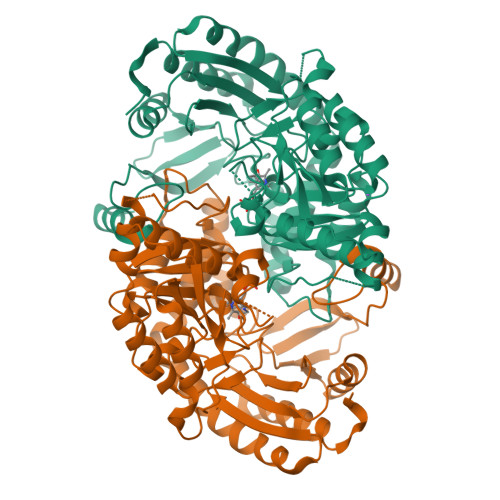Conserved and nonconserved residues in the substrate binding site of 7,8-diaminopelargonic acid synthase from Escherichia coli are essential for catalysis.
Sandmark, J., Eliot, A.C., Famm, K., Schneider, G., Kirsch, J.F.(2004) Biochemistry 43: 1213-1222
- PubMed: 14756557
- DOI: https://doi.org/10.1021/bi0358059
- Primary Citation of Related Structures:
1S06, 1S07, 1S08, 1S09, 1S0A - PubMed Abstract:
The vitamin B(6)-dependent enzyme 7,8-diaminopelargonic acid (DAPA) synthase catalyzes the antepenultimate step in the synthesis of biotin, the transfer of the alpha-amino group of S-adenosyl-l-methionine (SAM) to 7-keto-8-aminopelargonic acid (KAPA) to form DAPA. The Y17F, Y144F, and D147N mutations in the active site were constructed independently. The k(max)/K(m)(app) values for the half-reaction with DAPA of the Y17F and Y144F mutants are reduced by 1300- and 2900-fold, respectively, compared to the WT enzyme. Crystallographic analyses of these mutants do not show significant changes in the structure of the active site. The kinetic deficiencies, together with a structural model of the enzyme-PLP/DAPA Michaelis complex, point to a role of these two residues in recognition of the DAPA/KAPA substrates and in catalysis. The k(max)/K(m)(app) values for the half-reaction with SAM are similar to that of the WT enzyme, showing that the two tyrosine residues are not involved in this half-reaction. Mutations of the conserved Arg253 uniquely affect the SAM kinetics, thus establishing this position as part of the SAM binding site. The D147N mutant is catalytically inactive in both half-reactions. The structure of this mutant exhibits significant changes in the active site, indicating that this residue plays an important structural role. Of the four residues examined, only Tyr144 and Arg253 are strictly conserved in the available amino acid sequences of DAPA synthases. This enzyme thus provides an illustrative example that active site residues essential for catalysis are not necessarily conserved, i.e., that during evolution alternative solutions for efficient catalysis by the same enzyme arose. Decarboxylated SAM [S-adenosyl-(5')-3-methylthiopropylamine] reacts nearly as well as SAM and cannot be eliminated as a putative in vivo amino donor.
Organizational Affiliation:
Department of Medical Biochemistry and Biophysics, Karolinska Institutet, S-171 77 Stockholm, Sweden.


















